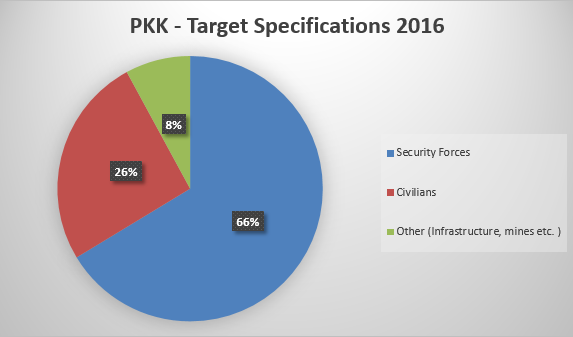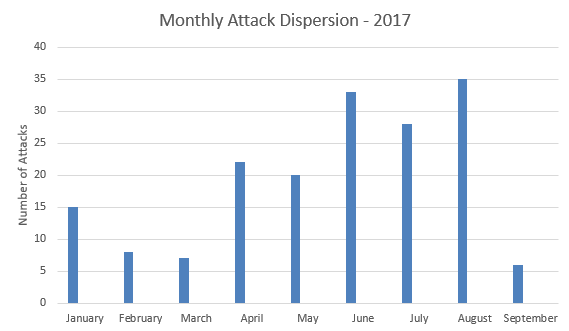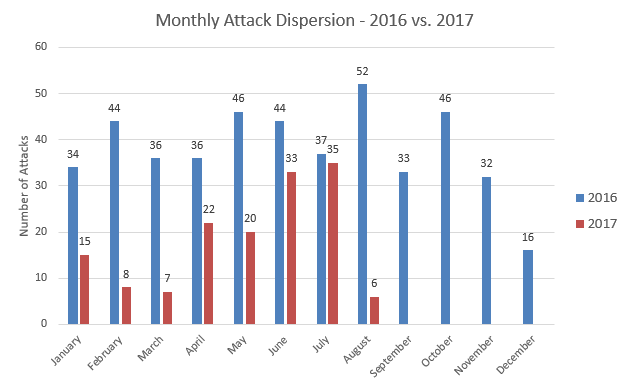PKK Attack Profile 2017
DRK Case Study
PKK Attack Profile - 2017
Overall number of PKK attacks in 2017
174 Attacks, 472 Casualties (164 dead, 308 wounded)
Overall number of PKK attacks in 2016
456 attacks, 3383 Casualties (737 dead, 2646 wounded)
Attack & Casualty Proportions
Overall PKK attacks decreased by 62% in 2017 while casualties by 86% when compared to 2016.
Geographical attack intensity/dispersion
Although security forces’ and PKK militants’ losses have remained largely concentrated in the south-eastern provinces of Hakkari, Şırnak, Mardin and Diyarbakır, violence was more dispersed in the south east over the past eight months. From December 2016 to July 2017, around 50 per cent of all confirmed fatalities occurred in these four provinces, compared to around 70 per cent in the previous sixteen months (July 2015-November 2016). Fatalities resulting from military operations rose in other south-eastern provinces, in particular Tunceli (28 confirmed militant deaths in February) and Bitlis (38 confirmed militant fatalities in May and June). Crisis Group also confirmed 29 militant fatalities in northern Iraq in March and April as a result of cross-border airstrikes by the Turkish military.
Confirmed fatalities in Tunceli, Bitlis resulted from the military’s campaign in the last spring to intensify its efforts to track down militants in mountainous areas and conduct cross-border operations in northern Iraq. At the same time, the military has been winding down operations in urban districts (such as Cizre, Sur, Silopi, Nusaybin, Yüksekova) located mostly in the provinces of Hakkari, Şırnak, Mardin and Diyarbakır, which is another factor possibly explaining the extension of deaths to other provinces. Yet, the intensity of attacks are not in the city centers but in the border lines. As such, city centers are not so dangerous as they seem to appear on daily news.

Target Specifications
Intensified operations of security forces against PKK in last two years forced terrorists to be confronted mainly with the security forces. This is the primary reason why the amount of security forces is higher than any other specific group according to PKK’s target specifications. There are 116 reported attacks targeting security forces in 2017. Civilians are the second mostly targeted group by PKK. Including the ones caught between two fires, civilian targets are generally the ones attacked by IED or other kinds of explosives. Yet, for PKK to continue its existence, situation is subject to change which might result in targeting civilians more than security forces. The rising trend of attacking infrastructures, road constructions, mine sites, pipelines has the third place. These attacks also caused civilian losses, specifically the workers in the context of collateral civilian damage. PKK has also been observed to target local people supportive of state and non-supportive of PKK.


PKK Losses According to Months
At least 1259 members of the illegal People's Defense Force (HPG), the PKK's primary armed wing, have been killed since July 2015. 233 militants of the illegal Civil Protection Units (YPS), a loose network of PKK urban youth militias, and 7 members of the illegal Kurdistan Freedom Falcons (TAK), a PKK affiliate responsible for attacks in western Turkey, were killed over the same time period.

PKK Attack Variation
The pie chart clearly demonstrates the increasing use of IED explosives by PKK. Intensive military operations conducted by security forces after mid-2016 forced PKK militants to change their attacking styles. So many successful operations proved the efficiency of counter-terrorism initiatives while forcing PKK to look for alternative attack variations. To hold up the Turkish security forces, and sustain PKK operationality, they prefer non-conventional military explosives, especially along the main supply roads. There are several reasons why militants use these devices. IEDs are relatively cheap and very easy to prepare. Also they can inflict rather higher casualties. Since IEDs can be detonated from a distance, militants can avoid direct armed confrontation, mitigating their own risks. There have been around 50 IED explosions reported by October, 2017. When compared to 131 IED explosions in 2016, one could see the ability of recent counter-terrorism operations in designating, recognizing and destroying since as considerable proportion of IED explosive have been defused. Yet, they seem to employ IED explosives due to aforementioned reasons in the upcoming future.


PKK Attack Dispersion
Even though the attack dispersion does not have a linear trend as seen in below-given graphs, there is a clear increase in the number of attacks in spring and summer months due to the extreme adverse weather conditions in winter period. Looking at the PKK attack dispersion in 2016 and 2017, the number attacks decreased to a large extent with respect to the every same months of the previous year. Such a decline is a proof that intensified counter-terrorism operations have panned out and the number of attacks and casualties have relatively been decreased. Government’s special focus on counter-terrorism operations are expected to bring clear-cut solutions in both preventing casualties and forestalling attacks.


Conclusion
Turkey’s ongoing war against PKK terrorism has proved considerable efficiency in 2017 while the intensified security operations visibly limited the mobility of PKK elements. As such, the statistics verify this condition as the number of attacks decreased 62 percent and casualties decrease 86 percent from 2016 to 2017. It seems inevitable to some extent that "Collateral Damage" continues to be point of security concern for the civilians in the midst of the direct clashes between PKK and the security forces. On the other hand, due its evolving inability to directly face against the security forces, PKK’s recent strategies have started to involve attacks against some selected civilian targets such as; high scale community infrastructure projects or mine sites and some prominent local figures who are non-supportive to PKK. Yet, DRK considers that, large scale foreign investment are not deliberately to be targeted by PKK. In other words, DRK considers that PKK targeting strategies may not likely to deliberately include foreigners or foreign investors. Moreover, DRK considers that the ongoing fight against PKK terrorism in and out of the country is a long-term process, through which the security concerns of local people, state officials, investors and foreigners will have been gradually eliminated.
